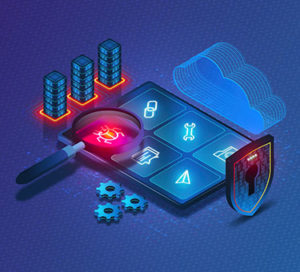How Does DAST Work?

DAST works by using automation that simulates different malicious attacks on an application while it’s running. The outcome is to detect if there are any unexpected or undetected code or security defects that can be exploited by an attacker. Cross-site scripting, command and SQL injection errors, path traversal, and insecure server configuration are a few of those security risks that can be detected by DAST.
DAST tools don’t require access to the source code. They can emulate an external attack with limited working knowledge and information about the application.
DAST solutions vary, from traditional dynamic scanning and application runtime analysis to modernized solutions that can combine additional API, web, and penetration testing. Additional next-gen technology scanning tools can also include interactive application security testing (IAST) integrated into increasingly popular CI/CD environments.
Why Is DAST Important? (or What Role Does DAST Have?)
Technology never stops evolving. New and different attack combinations are continually being attempted. This makes application security increasingly difficult and time consuming.
DAST helps developers secure applications by conducting security checks during the software development life cycle (SDLC). Using automated DAST enables developers to focus on developing, while DAST conducts product audits and discovers known and unknown vulnerabilities . Checking and correcting vulnerabilities early in the development phase minimizes the chance of a compromise and helps prevent damage to company reputation.
A growing trend is Secure DevOps or DevSecOps – the inclusion of security testing in CI/CD environments. Adding this step during the course of development can save a company remediation time and the cost of a fix or compliance penalty after deployment. DAST is also extremely important for making sure your organization is NERC CIP and PCI compliant.
DAST vs. SAST: What’s the Difference?
| SAST | DAST | |
|---|---|---|
| Type | White box security testing | Black box security testing |
| Process | Like a developer | Like a hacker |
| Requirements | Source code | Running application |
| SDLC | Earlier stages | Later stages |
| Cost of Fix | Less expensive | More expensive |
| Issues Discovered | Can’t find runtime issues | Can find runtime issues |
| Scope | Language/platform specific | Many languages & platforms |
| Software | All | Software & hardware |
SAST and DAST are both application security testing solutions, but the difference is in static versus dynamic. Static testing uses the source code to test line by line before the code is compiled, whereas dynamic testing executes its scan while the application is running, from the outside, without access to the source code.
SAST scans as if it were a developer and DAST scans as if it were a user of the application, making both essential to pre and post launch security success. Whether you’re trying to find security coding issues early on in development with SAST or if you’re trying to find DAST runtime errors and misconfigurations in real-time, both have security scanning advantages in the Software Development Lifecycle (SDLC).
Using SAST and DAST together provides a 360-degree view of your application’s security. They both reduce the chance of introducing vulnerabilities to production, but each have their own methods of detection.
DAST Pros and Cons
Pros
Cons
No source code needed
No code base
Can find run-time issues
Experts needed
Finds misconfigurations
Slow scans
When to Choose DAST
Choose DAST if you do not have access to source code or the complexity of the code requires dynamic analysis.
DAST solutions are a reactive approach to security, but they still have benefits that SAST tools don’t offer. The primary benefit is the ability to scan your entire attack surface across multiple servers, environments (e.g., cloud and on-premises), API endpoints, and other infrastructure. For example, you could have applications that work with your API endpoint that receive and deliver data. A DAST solution can be configured to scan endpoints for vulnerabilities in addition to the main application.
Although DAST solutions offer a more comprehensive scan of your environment, they have a few disadvantages. DAST solutions must be configured for your environment, so it requires a bit more knowledge in penetration testing and exploitations. If the environment is not well audited, you could miss an entry point and unknowingly have vulnerabilities.
A full scan of the environment could be overwhelming to developers. If they don’t know where the vulnerable code exists or understand reports, it could be difficult for developers to identify the functionality causing the issue. A DAST tool requires more knowledge of the OWASP Top 10 and what could happen in exploitation of the code.
Another concern with DAST tools is its limitations. DAST works with web-based applications, so you would need additional security support for software that cannot be scanned over the network (e.g., local desktop applications).
Industry Use Cases
There are many industries that need SAST and DAST to secure applications. It’s a crucial step to achieving and maintaining many compliance standards. Any industry that handles proprietary data, such as, payment, banking, or Protected Health Information (PHI), must use the full range of vulnerability management and application security tools to ensure sensitive customer data is protected and secured.

The automotive industry has internet-connected vehicle safety requirements that make DAST and SAST testing essential. Vehicles have a growing number of Internet of Things devices and internet-connected functions that can cause safety issues if targeted by malicious actors. Automotive safety standards have increased to the point where both SAST and DAST are needed to meet safety compliance for mass-produced, internet-connected vehicles. is an example.
The medical industry is required to protect against the theft of PHI, but there’s another aspect of security that shouldn’t go overlooked. Many medical devices may include online connectivity as a feature, whether in a medical facility or a personal wearable device that a patient relies on. Examples of these devices are health monitors, insulin pumps, and pacemakers. Devices with online or Bluetooth connectivity are at risk for malicious activity and require testing to protect the patient’s device from a cyberattack. Complete continual scanning during development and after deployment is necessary to keep patients and their data safe from attacks.
DAST Solutions from Beyond Security
BeSTORM uncovers unknown vulnerabilities. Its DAST goes beyond automatically testing millions, even billions, of attack combinations to feature black box fuzzer capabilities that help ensure the security of applications and protocols before they’re released. The combination of DAST’s comprehensive, calculated testing with the outsized attacking ability of the Black Box Fuzzer tests application security from every outside angle, saving time and preventing costly security fixes after release.
BeSTORM offers over 250+ prebuilt protocol testing modules, plus, the ability to add custom and proprietary protocols. Get quality assurance on your application security at your own testing center with the capability to scale up or down with any business.